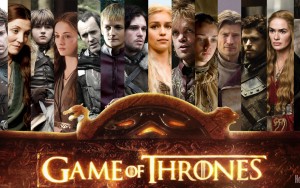Guest Blogger Post by Brandon Engel
Without Conan the Barbarian or Lord of the Rings, there’d be no Game of Thrones
With the fifth season of the hit HBO series Game of Thrones getting ready to launch, it’s as good a time as any to dive a little deeper into George R. R. Martin’s A Song of Ice and Fire novels, which serve as the basis for the television series. Even devoted fans of the show may not realize how much Martin was influenced by older books that explored similar themes and historical events. When you catch the season premiere (check HBO Go or DTV for info), keep in mind that this great series wouldn’t be possible without a couple classic fantasy authors’ influences.
In a nutshell, A Song of Ice and Fire (with Game of Thrones being the first book in the series) is about powerful warring families and the quest for the iron throne. As the series progresses, there’s an unexpected threat from beyond the northern border. The central character in the series is the deposed king’s daughter who has been exiled. Originally, the series introduces fewer than a dozen characters, expanding to more than thirty as the three basic stories unfold throughout the books.
Martin’s most obvious influence is J.R.R. Tolkien’s Lord of the Rings series. As with Lord of the Rings, all of the characters—except for Daenerys Targaryen—in A Song of Ice and Fire start out together and eventually split up and have their own separate adventures. The two tales also share a penchant for the restrained use of magic with characters who tend to prefer the sword to the wand.
Robert E. Howard, who is considered the father of the sword and sorcery genre, provided influence for Martin with his Conan the Barbarian character who used his physical abilities as his main weapon. The T. H. White influences tend to be a little easier to see, particularly in reference to that author’s most famous King Arthur stories—The Sword in the Stone and The Once and Future King.
Martin has also tried to add some realism to his fictional world by drawing inspiration from historical fiction writers like Thomas B. Costain, Bernard Cornwell, Philippa Gregory, Frank Yerby, and Sharon Kay Penman. The author has even found inspiration from the science fiction and horror genres, possibly explaining the diverse characters and plot lines that tend to populate his fictional universe.
Some of the geographic elements of the fictional continents of Westeros and Essos were also influenced by real world locations. Hadrian’s Wall, for example, is based on a real wall of the same name that Martin explored while visiting Scotland. Of course, the fictional wall is more massive and magical than the real thing. Speaking of Scotland, the Red Wedding borrows elements from the Black Dinner and the Glencoe Massacre—real life events more than 200 years apart.
While Martin admits to being inspired by other historic events like the Wars of the Roses, he has said in interviews that there really is no character-for-character comparison to real people in history. This, however, hasn’t stopped some fans from seeing shades of historical figures in some of the A Song of Ice and Fire characters, such as Henry VIII in the form of Robert Baratheon.
With influences ranging from Lord of the Rings to Conan the Barbarian, Games of Thrones presents an impressive mix of fantasy and reality in a way that’s truly captivating. It’s also worth mentioning that Martin willingly admits to having drawn from all of the sources referenced here—plus a few others. Digging a little deeper into Martin’s influences, however, might just spark a greater appreciation for the dynamic world he’s created.



